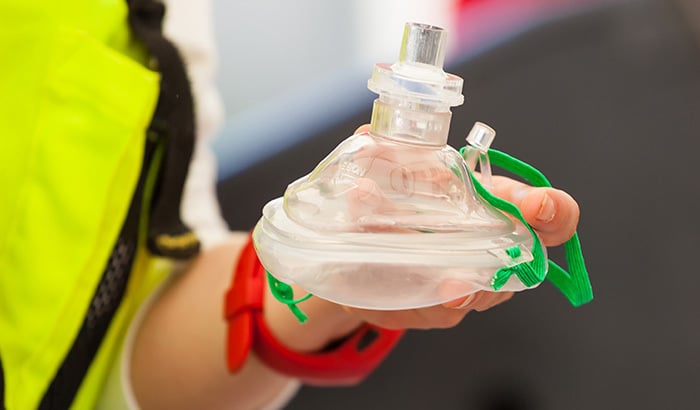Devices like pocket resuscitation masks can be lifesavers in emergency situations. Life-threatening situations can be challenging to deal with, but having the right equipment can be the difference between life and death for afflicted individuals.
In the event that a person requires emergency CPR, a pocket resuscitation mask offers a convenient and ready-to-use mouth-to-mask setup that allows you to perform immediate respiratory support without compromising yourself.
The Purpose of a Pocket Resuscitation Mask
Pocket resuscitation masks are meant to minimize cross-contamination and improve hygiene during mouth-to-mouth resuscitation. Traditional CPR methods put the resuscitator at risk of contracting germs or diseases, which is why these devices are a must today.
Additionally, a CPR mask can improve airflow, which increases the chances of successfully resuscitating an individual suffering from a heart attack or someone who may have just been rescued from drowning.
CPR masks create a seal over the person’s nose and mouth, and all airflow travels through a one-way filter, making its way straight into their airways.
What a Pocket Resuscitation Mask Looks Like
These masks offer a crystal clear look to monitor a patient’s color, which gives you an immediate indication of their condition and the effectiveness of the CPR administration. They’re often ergonomically shaped with a soft-air cushion to prevent leaks.
A reliable mask will often feature a foldable cushion mask with an oxygen port and an elastic head strap for support.
Types of Pocket Resuscitation Masks
Not all pocket CPR masks are the same. Different masks will have different styles and intended applications.
Age-Dependent Masks: CPR pocket masks often list their intended age range on the packaging. Universal masks are the ideal option, but sometimes you may not be lucky enough to have one on hand.
While infant-specific masks will only work on infants and children, in some cases, adult masks may also be compatible with children. Make sure you read a mask’s sizing instructions and specifications before purchasing one.
Practice Masks: If you take a CPR training class, you’ll likely encounter a practice mask. These masks can be real, but the filters and valves remain unreplaced after each session. You should update and maintain these masks before using them on an actual person.
Oxygen Compatible Masks: Some pocket resuscitation masks are compatible with supplemental oxygen. These masks will often include a head strap for effective administration.
Mask Kits: Mask kits are a wise investment because they often come with essential accessories such as disposable gloves, alcohol wipes, an oxygen valve, and a storage case.
Things to Know Before Buying Pocket Resuscitation Masks
The question isn’t whether you should buy a resuscitation mask; rather, should you settle for the first one you find. If you’re looking to buy these masks for your practice, there are some things to consider.
Is the Mask Universal?
It’s important to know if the type of mask you’re buying is universal. A universal mask will fit over an adult, child, or infant’s mouth. These masks are more practical and efficient in usability no matter who happens to find themselves in an emergency.
Does the Mask Have a Filtered One-way Valve?
The pocket resuscitation masks you intend to purchase should also come with a filtered one-way valve. This valve prevents cross-contamination between the provider and the patient since the valve is only one way and filters the air.
These valves should also be replaceable and detachable for easy replacement.
Make sure the Masks are 510k Approved
The FDA does not endorse specific medical devices, but there is a way to see which products may offer more reliability. Some medical products come with a 510(k) number, a premarket notification number that is required for CPR masks.
Though the FDA cannot endorse these masks, the products should still be registered with them.
Look Out for a Head Strap
CPR masks should also come with a head strap, ideally made from elastic, since this can facilitate hands-free operation during an emergency. It’s easier for an individual to administer CPR if the mask stays put on the individual.
Make Sure the Mask Comes with Alcohol Wipes and Latex Gloves
Though not necessary, a mask with some sort of disinfecting wipe and latex gloves is recommended. Alcohol wipes, for example, can help prevent infection, while a pair of latex gloves provide an added layer of protection for the parties involved in the resuscitation.
How to Prepare and Use a Mask in an Emergency Situation
A person administering CPR must know how to use a CPR mask in an emergency situation properly. If someone needs resuscitation, one should first call 911 and then proceed to do the following:
- Inspect the CPR mask to ensure all parts are attached and intact.
- Secure the mask around the individual’s head and place the dome over their mouth and nose. Make sure you get a proper seal.
- Apply chest compressions according to training specifications.
- Open the respiratory valve and blow through it so the victim receives oxygen.
- Check the patient’s pulse and breathing, continuing CPR procedures as needed.
These are general tips, but a person administering CPR should always follow what they learned in a reputable CPR class.
After use, it’s crucial that the individual clean and disinfects the mask, discarding and replacing parts such as the filters and valves to prevent the spread of germs among patients.
Get Quality Medical Supplies from Allied USA
Pocket resuscitation masks are a must in any medical practice. Of course, you want to ensure that you’re getting the highest quality products available to help your clients to the best of your abilities. If you’re looking for a new medical supplies vendor, get in touch with us at Allied USA.
We’ll buy out your current vendor’s contract and supply you with the best essential medical supplies for your practice. Call us at 801-328-8581 or fill out our online form to request a free quote.

